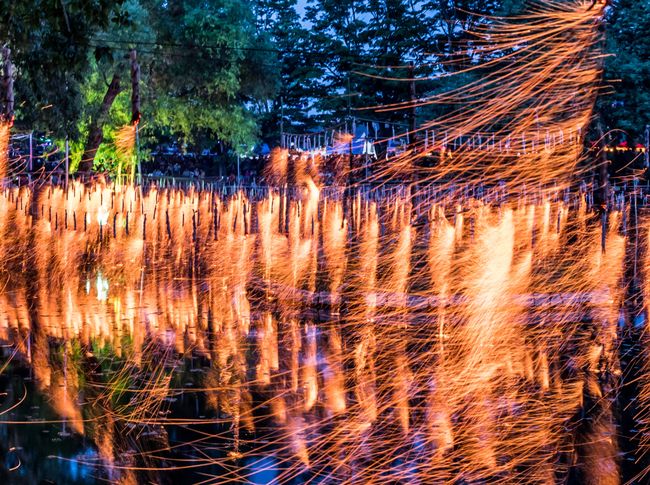A traditional fireworks festival, where thousands of sparks turn a pond red, has recently become popular. It is called ‘Nakhwanori,’ which is one of Korea’s traditional folk games. These are traditonal fireworks where ‘nakhwabong’ are made by putting charcoal powder into hanji(Korean traditional paper) and twisting it around cotton cloth as a wick, which is then strung up and lit. Mainly, nakhwabongs are hung on iron wires or bamboo sticks. When they are lit, the sparks scatter down, creating a scene that resembles flower petals falling. This festival is usually done over water, and is held the first moon of the lunar new year and on Buddha’s Birthday. The Nakhwanori festivals in Haman and Muju Anseong are especially famous. It has gained even more popularity recently. Now Pharos is going to learn about the history and famous locations of Nakhwanori.

The exact origin of Nakhwanori is unclear, but it is known as part of the traditional fireworks culture or the Joseon Dynasty. According to , it is said that in the 16th century, the governor of Ham-an, Jeong Gu first started Nakhwanori during the reign of King Seonjo of the Joseon Dynasty. At that time, Joseon was going through a period of political instability because of factional politics, and the people struggled in their daily lives. Economically, there was a severe gap in land ownership, which caused farmers to lose their livelihoods and become homeless. In this historical context, Nakhwanori is said to have started for people to pray for the well-being of the people and good harvests. There are records that during the reign of King Seonjo, after Ryu Seong Ryong retired from his government position and returned to his hometown, he enjoyed it with his brother on the Nakdong River. However, during the Japanese Occupation, it was almost lost due to Japan’s policy of cultural genocide. Thanks to the efforts of local residents to restore it, the festival has recently become an important regional event supported by many local governments across the country.
Today, Nakhwanori is held in various regions of Korea as part of festivals, with each area preserving the tradition in its own unique way.
Haman Nakhwanori (Haman County, Gyeongsangnam-do)
This is the largest Nakhwanori event in Korea. Fireworks sticks are hung on long iron wires along the riverside and set on fire, creating a mysterious scene as the sparks fall onto the water. Many visitors come every year to experience Korea’s traditional fireworks culture.
Event date: Lunar April 8 (Buddha’s Birthday) every year
2025 schedule: May 5
Andong Hahoe Village Seonyu Julbulnori (Andong City, Gyeongsangbuk-do)
This is a traditional folk performance held in Hahoe Village, a UNESCO World Heritage Site. It features a unique form of fireworks called ‘Julbulnori,’ where fire travels along long ropes hanging over the river. This creates a spectacular sight that looks like the flowing Milky Way.
Event date: Lunar July 16 every year
Bongduri Haechon Nakhwanori (Yeoju City, Gyeonggi-do)
Held the day after Jeongwol Daeboreum, this event is a village ritual to pray for a good harvest and peace. Watching the flames burn at the end of winter while wishing for good fortune in the new year makes this a unique event linked to traditional beliefs.
Event date: The day after Jeongwol Daeboreum every year
Muju Anseong Nakhwanori (Muju County, Jeollabuk-do)
This event is preserved by the Dumun-ri Nakhwanori Preservation Society and has been designated as an intangible cultural heritage of Jeollabuk-do. It was also selected as the best small-town festival in Jeollabuk-do for two consecutive years, proving its cultural value.
2025 schedule: June 6 ~ June 7
The dreamy atmosphere and artistic beauty of Nakhwanori have been featured in movies, dramas, variety shows, and music videos, leaving a strong impression, especially in historical dramas and romantic scenes. In Season 4 of the variety show ‘1 Night and 2 Days,’ the members experienced Haman Nakhwanori by making their own fireworks sticks. The festival also appeared in the ending scenes of episode 1 of ‘Bloody Heart,’ episode 12 of ‘Revenant,’ episode 9 of ‘See You in My 19th Life,’ and episode 9 of ‘Destined with You’ to create emotional and dramatic effects. Additionally, BTS RM’s solo song ‘Wild Flower’ used fireworks in its music video to deliver a deep message about life and fading moments. Through these cultural references, Nakhwanori has evolved beyond traditional performances into modern cultural content, enhancing its artistic value.
Nakhwanori is not just about fireworks. It is a centuries-old tradition and a uniquely Korean fireworks tradition. It began as a pastime enjoyed by our ancestors and has now been recognized as a National Intangible Cultural Heritage by the Korean government. Today, it continues to appear in entertainment, drama, and music, offering new emotional experiences. Nakhwanori maintains its cultural significance while blending with modern sensibilities, allowing it to be reinterpreted in new ways. As the sparks light up the sky and disappear in an instant, they leave behind a deep impression and lingering emotions. Even as time passes, Nakhwanori continues to brighten people's hearts, and it is anticipated that its beautiful glow will be cherished for generations to come.
81st Reporter • AN KEUM HYUN • angeumhyun1@gmail.com
- TAG









